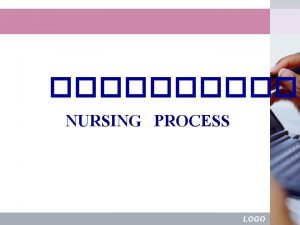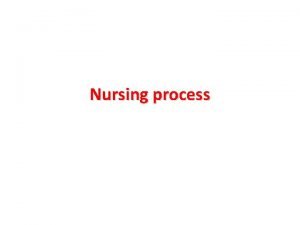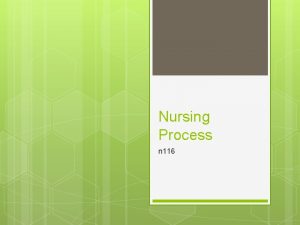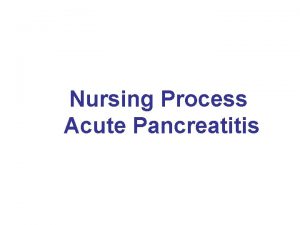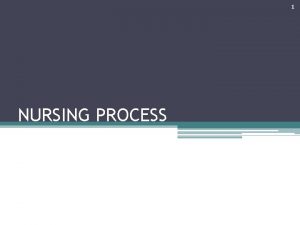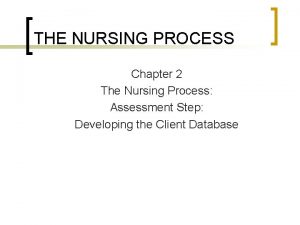THE NURSING PROCESS The nursing process is the















- Slides: 15

THE NURSING PROCESS The nursing process is the framework for providing professional, quality nursing care. It directs nursing activities for health promotion, health protection, and disease prevention and is used by nurses in every practice setting and specialty. “The nursing process provides the basis for critical thinking in nursing” (Alfaro -Le. Favre, 1998, p. 64).

Comparison of Medical Diagnoses and Nursing Diagnoses Medical Diagnosis Nursing Diagnosis Focuses on the illness, injury, or disease process. Focuses on the responses to actual or potential health problems or life processes. Remains constant until a cure is effected. Changes as the client’s response and/or the health problem changes. Identifies situations in which the nurse is licensed and qualified to intervene. Identifies conditions the health care practitioner is licensed and qualified to treat.

THE STEPS IN THE NURSING PROCESS Outcome identification

Assessment Techniques • The four assessment techniques used in physical examination are inspection, palpation, percussion, and auscultation.

THE STEPS IN THE NURSING PROCESS Outcome identification

Types of Nursing Diagnoses Analysis of the collected data leads the nurse to make a diagnosis in one of the following categories: • Actual problems • Potential problems (including those where risk factors exist and there are possible problems) • Wellness conditions • Collaborative problems

THE STEPS IN THE NURSING PROCESS Outcome identification

OUTCOME/GOAL IDENTIFICATION AND PLANNING AS A STANDARD COMPONENT OF CARE: ANA STANDARDS Outcome Identification • The nurse identifies expected outcomes individualized to the client. Guidelines • Outcomes should be: • Based on diagnoses • Documented in measurable terms • Developed with the client and health care providers • Realistic and achievable Planning • The nurse develops a plan of care that prescribes interventions to attain expected outcomes. Guidelines • Planning should: • Be individualized to the client’s needs and status • Be developed with the client, significant others, and health care providers • Be documented • Promote continuity of care SMART

THE STEPS IN THE NURSING PROCESS Outcome identification

Categories of Nursing Interventions • Observation • Treatment • Prevention • Health Promotion

THE STEPS IN THE NURSING PROCESS Outcome identification

EVALUATION AS A STANDARD COMPONENT OF CARE: ANA STANDARDS Evaluation The nurse evaluates the client’s progress toward attainment of outcomes. Guidelines Evaluation must: • Be performed as a systemic process • Occur on an ongoing basis • Lead to revision of the plan of care when needed • Involve the client, significant others, and other members of the health care team • Be documented

Form NCP (Nursing Care Plans) Pt. Name: No. Date/Time Age: Room/Bed: Nursing Diagnosis* *must be with reference(s) Medical Diagnosis: Planning Goal* Interventions* Physician’s Name: Implementation Rationale* Evaluation

Form NCP (Nursing Care Plans) Pt. Name: No. Age: Date/Time Room/Bed: Nursing Diagnosis Medical Diagnosis: Intervention Physician’s Name: Implementation Evaluation

Case Pada tanggal 6 juli 2012, Ny. Rita datang ke RSAM bagian darurat pada jam 07. 00 dengan keluhan rasa nyeri di abdomen bagian kanan bawah yang dialaminya sejak seminggu yang lalu. Setelah diperiksa dokter, ternyata pasien mengalami appendicitis. Kemudian pasien dibawa ke ruangan perawatan di kamar 203 -1, oleh perawat ER untuk rawat inap. Kemudian pada jam 08. 00 Ns. Merry mengecek VS pasien dengan T= 38, 5 o. C, P=110 x/m, R=24 x/m BP=130/90 mm. Hg. Pasien belum BAB sejak dua hari yang lalu, wajah pasien tampak kemerahan dan meringis kesakitan, badan pasien teraba hangat dan berkeringat, pt masih mengeluh nyeri pada abdomen kanan bawah skala nyeri 8 dari (0 -10), pasien mengatakan nyeri terasa seperti ditusuk-tusuk benda tajam, nyeri menjalar dari abdomen sampai ekstrimitas bawah, nyeri dirasakan pada saat kaki ditekuk dan pada saat berdiri. Pada jam 08. 30 pasien di pasang infus NS 15 tetes per menit di tangan kanan dan jam 09. 00 pt di kompres air hangat oleh perawat dan pasien juga dianjurkan minum air hangat 250 cc/jam. Pada jam 09. 30 pt di beri obat Sanmol 25 gram (PRN), Sumagesic 500 mg (PRN) sesuai order dokter. Kemudian pada jam 09. 45 pasien di pasang kateter no. 18 dengan balon 15 cc. Pada jam 11. 20 pengambilan VS oleh Ns. Merry T=37, 5 o. C, P=95 x/m, R=21 x/m Bp=130/90 mm. Hg. Pasien sudah BAK belum BAB, pasien makan ½ porsi.
 Nursing diagnosis three parts
Nursing diagnosis three parts Nursing process in psychiatric nursing
Nursing process in psychiatric nursing Hát kết hợp bộ gõ cơ thể
Hát kết hợp bộ gõ cơ thể Ng-html
Ng-html Bổ thể
Bổ thể Tỉ lệ cơ thể trẻ em
Tỉ lệ cơ thể trẻ em Chó sói
Chó sói Tư thế worm breton là gì
Tư thế worm breton là gì Hát lên người ơi alleluia
Hát lên người ơi alleluia Môn thể thao bắt đầu bằng từ chạy
Môn thể thao bắt đầu bằng từ chạy Thế nào là hệ số cao nhất
Thế nào là hệ số cao nhất Các châu lục và đại dương trên thế giới
Các châu lục và đại dương trên thế giới Cong thức tính động năng
Cong thức tính động năng Trời xanh đây là của chúng ta thể thơ
Trời xanh đây là của chúng ta thể thơ Mật thư anh em như thể tay chân
Mật thư anh em như thể tay chân 101012 bằng
101012 bằng



















